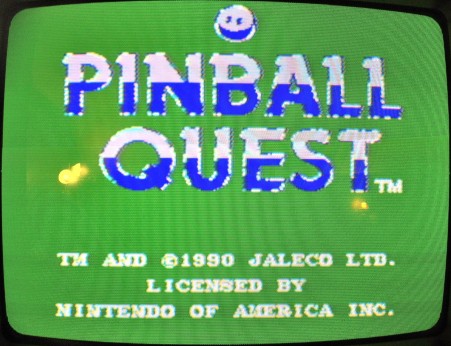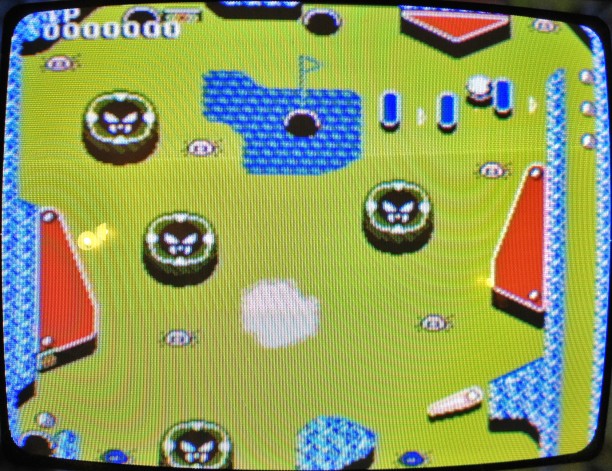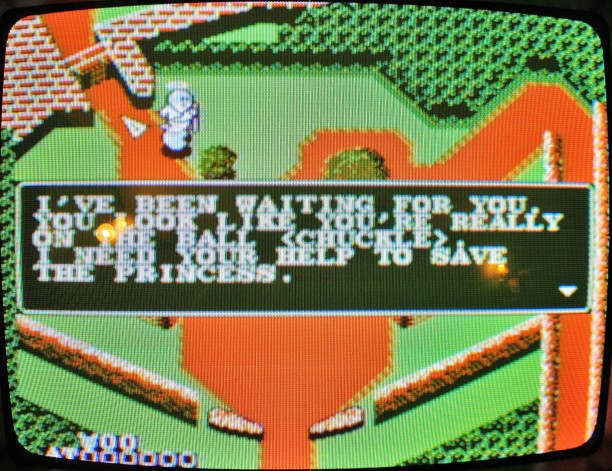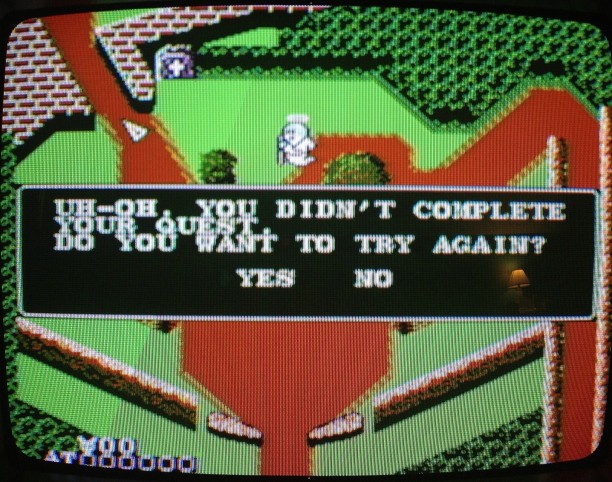
Pinball Alley
Pinball Alley: Pinball Quest
Pinball Quest is the last stop for the Pinball Alley series, and it is perhaps the most creative experience of all of the NES pinball games. While it does offer traditional pinball experiences by virtue of three unique tables, the game’s biggest draw comes from the RPG Mode. It was a great idea for its time, combining two distinct genres of games and mashing them up into a fairly enjoyable– though occasionally frustrating– experience, and we would see Zen Studios resurrect the RPG/pinball mix via the Epic Quest table in 2012.
But let’s not get ahead of ourselves and talk about the traditional pinball tables that Pinball Quest has to offer first.
The first table is called Pop! Pop!, but it has nothing to do with balloons. It’s actually a salute to United States culture. The table is adorned with stars and stripes, and has nods to bowling and pool as leisure activities. The table is split into two levels. and one set of flippers must be manually alternated from one level to the other as the ball travels. This becomes a necessary skill to learn and anticipation and attentiveness are keys to success here. Of note in the top level is a triangle of bumpers, a capture hole, and three bowling pins. The lower level has more bowling pins to take down with the ball and, when certain conditions are met, a capture hole appears in the center of the jukebox that will send players to a minigame on the pool table in the top left. Overall, the Pop! Pop! table is okay. The pool minigame is fun and I like the theme of the design, even if the layout is a bit haphazard.
Next up is Viva! Golf. As you might expect, this table takes players out to the links, where sand traps, water hazards, and evil gophers await. (Yes, I said evil gophers, and not like the scamps from the No Good Gofers and Tee’d Off! pinball tables from Williams and Gottlieb, respectively.) This is also a bi-level table, but this time the flippers are static and allow players a bit of a break from level switching. As with any golf course, there are a lot of holes all over this table. There’s a hole on the green on the top level, four holes with gophers in them on the bottom level, and a few other holes that the ball can find during the course of a turn. The main objective here is to hit all four gophers on the lower level and then put the ball in the hole on the green located on the top level to defeat the Evil Gopher. I like golf, so this table wound up becoming my favorite of the three traditional tables in the game.
The last of the traditional tables is called Circus. Keeping with the theme, the table is decorated with clowns, seals, and lions. It’s also a bi-level table and uses the level switching technique for the flippers that Pop! Pop! uses. This table has the most traditional layout of the three, with vertical rollovers at the top, a ramp-like shot from the bottom level to get back to the top, and inside and outside flipper outlanes. On the lower level, there is also a slot machine that can be activated via a capture hole shot on the right-hand side. It’s the table’s most unique feature, but the rewards are negligible. The “ramp” shot in top-left corner of the lower level is fairly easy to pull off, and, as with all tables that have multiple screens or levels, it’s recommended to master this shot to keep the ball in play longer. This is the most forgiving of the three tables and it’s likely that the highest scores will be achieved here.
The three tables do have issues with quick ball drains, either via the center or down the outlanes. The feel is more like pinball machines in arcades, where it sometimes felt as though the bounces were meant to go against you. This mentality really doesn’t work for original pinball games meant to be enjoyed in the home. There isn’t revenue to be made here by constant quarter/token insertion, and the overall experience can end up being more frustrating than satisfying. It’s understood that these traditional tables aren’t the stars of the show in Pinball Quest, but they could have been better additions to the overall experience if the ball physics and difficulty had been tweaked just a bit. We didn’t see this fault in traditional games like Rollerball and Pinball, and even the arcade conversions of Pin*Bot and High Speed were more fair. It’s a shame, really. The tables are also lacking in traditional features. There are no extra balls to be earned, no outhole bonuses to be collected, and no bonus multipliers.
With those tables out of the way, that leaves the RPG Mode to cover. Some players hail it as the coolest pinball experience on the NES. It’s definitely original. Unfortunately, the same physics and drain problems that plague the traditional pinball tables plague the RPG Mode at times, making it frustrating despite its originality.
The basic theme of the RPG Mode is that you, as a pinball warrior (just go with it), must save the princess. In order to do so, players must help the pinball warrior defeat enemies by ramming into them and depleting hit points each time. The first stage is fairly simple, as players just have to hit gravestone targets and a gate to summon the ghost of a fallen pinball guard who was guarding the spherical maiden. From there, the goal is almost always up. Some stages are bi-level, much like the traditional tables I described earlier. Those stages also require level switching for the flippers, so if you haven’t practiced this skill before trying the RPG Mode, it can get pretty hairy.
As you ascend to each level, there are different table layouts and different boss monsters to defeat, each with its own amount of hit points. The difficulty level for these stages is pretty uneven, too. For example, the wizard stage can be maddening. Each time the ball drains, some attack power is lost and the player must fight through enemies to get back inside and face the boss again. Patience is an absolute must here, because the ball will drain. A lot. It’s largely because of the way that the stage is laid out. There’s a narrow path that players can shoot the ball straight up through in order to reach the wizard on the top level. The problem is that, if the ball drains through the center during the battle, it’s almost a certainty that the ball falls all the way down and off the stage entirely.
For patient players who don’t mind replaying lower stages, gold (points) can be collected and used at shops in-between each stage to purchase power-ups including special flippers and lane stoppers. They are definitely helpful for keeping the pinball warrior in play on a particular stage, but if the ball does drain without defeating the boss… the items are lost and the money spent is basically wasted. Therefore, it’s advisable that players learn the table layout of each stage and identify boss movement patterns before spending money on those power-ups. Gold points aren’t exactly plentiful, either, so economical use of them is important.
There is a total of five bosses in RPG Mode, so the overall adventure isn’t very long. There isn’t a password or battery save feature, either… so if you’re able to get pretty far, it’s best to stick with it and try to see the mode through to the end. Each successive table layout gets more complex and each boss is a bit stronger than the last. There’s some building pressure not to have the ball drain as you progress, as having to face bosses again to regain access to the later levels can get really frustrating. It’s a pretty cheap way to extend the length of the adventure, honestly, but the game is meant to be a challenge.
Pinball Quest is neither the best-looking nor the best-playing pinball game that the NES has to offer. It does, however, offer something in a pinball title that none of the other five games for the platform can match. The RPG Mode is certainly worth trying. It was a bit before its time, and probably could have been fleshed out a bit more if a sequel had come around. There are monster battles, stats, items, and a pretty steep challenge for even the most skilled pinball wizards to try and overcome. In fact, it can even be argued that the traditional pinball tables included on the cart are more preparation tools for the RPG Mode in learning the ball physics and getting used to level switching than being offered as traditional experiences.
If nothing else, Pinball Quest is the most unique of the NES pinball titles. That alone may be enough for platform owners to consider adding it to their libraries. It can usually be found for less than $10 loose, and it’s judged as only a 3 on the NintendoAge Rarity Ranking Chart… so it shouldn’t be too difficult to find. (Interestingly enough, the last updated NES Rarity List at NES HQ deems the game a bit more uncommon.)
Speaking of pinball quests, mine has just about ended here at 1 More Castle. It’s been an honor and a privilege to cover these games and to share my thoughts and strategies with you over the last three months, and I would like to extend my gratitude to Jason Lamb for editing these verbose monstrosities into a more readable state and to Eric Bailey for giving me the opportunity to write about these pinball games in such a great environment as the one found here. Thanks also to all of you who have been reading my work and leaving comments. That’s what means the most to me, and I’m very appreciative.
Don’t fret just yet, though– there is still one more column to be written, and you’ll see it on June 4th.


